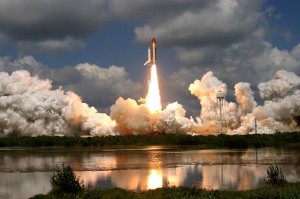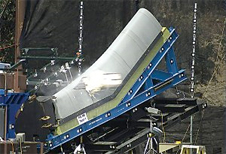If you live in Berkshire there’s a great chance to meet NASA Engineer Matt Melis over half term. Matt is delivering a special presentation for TeenTech at University of Reading at 10.30am on 28th October. It’s a lively, illustrated talk, with stunning video clips and stills and although technical, engaging for all ages.
If you’re curious about space exploration and want the inside track on NASA , what it takes to be a space engineer and how NASA changed it’s approach as a result of lessons learnt from the Challenger and Columbia disasters then come and join us.
Please note : The Reading event is now fully booked.
Event details
 The Space Shuttle is the most complicated machine designed by human beings. An extraordinary team of thousands has tirelessly committed itself to safely flying this vehicle since 1981. Thirty years and 135 missions after STS-1, the final Shuttle mission lifted off from Kennedy Space Center on July 8, 2011. During the three decades of Space Shuttle Flight, NASA had countless great triumphs and two significant tragedies – Challenger and Columbia. From both tragedy and success, the NASA team took lessons enabling Shuttle to fly safer after every mission.
The Space Shuttle is the most complicated machine designed by human beings. An extraordinary team of thousands has tirelessly committed itself to safely flying this vehicle since 1981. Thirty years and 135 missions after STS-1, the final Shuttle mission lifted off from Kennedy Space Center on July 8, 2011. During the three decades of Space Shuttle Flight, NASA had countless great triumphs and two significant tragedies – Challenger and Columbia. From both tragedy and success, the NASA team took lessons enabling Shuttle to fly safer after every mission.
Matt Melis provides a look into the inner workings of the Space Shuttle and a behind the scenes perspective on the impact analysis and testing done for the Columbia Accident Investigation and NASA’s Return to Flight programs. His presentation is full of rich, still and motion picture imagery, and, although technical, is easily understood by all audiences. In addition, highlights from recent Shuttle missions are presented demonstrating how NASA conducts it’s operations differently today as a consequence of the lessons learned from Challenger and Columbia.
Matt received both a BS in Civil Engineering and an MS in Engineering Mechanics from Michigan State University and has worked at the NASA Glenn Research Center for twenty six years. His primary area of focus is in advanced finite element modeling and analysis methods including nonlinear and dynamic impact loading. Trained in engineering mechanics, he has been recognized for expertise in actively cooled structures, stress analysis, ballistic impact research, and multiphysics analysis during his tenure at the Research Center. He has worked on numerous aeronautics and space programs for the agency including the International Space Station, the Space Shuttle and NASA’s Exploration Program.

Foam strike testing of fiberglass paneling conducted at a Southwest Research Institute facility. Photo Credit: CAIB Report
In the four and one half years that followed the Columbia accident, Matt was assigned full time to working the Columbia Accident Investigation and the Shuttle Return to Flight Program as technical lead of the NASA Glenn Ballistic Impact team. Most recently Matt has worked on landing impact testing of various design concepts for the Orion crew module and is currently involved in a high-temperature materials development program for NASA’s Hypersonics Program
